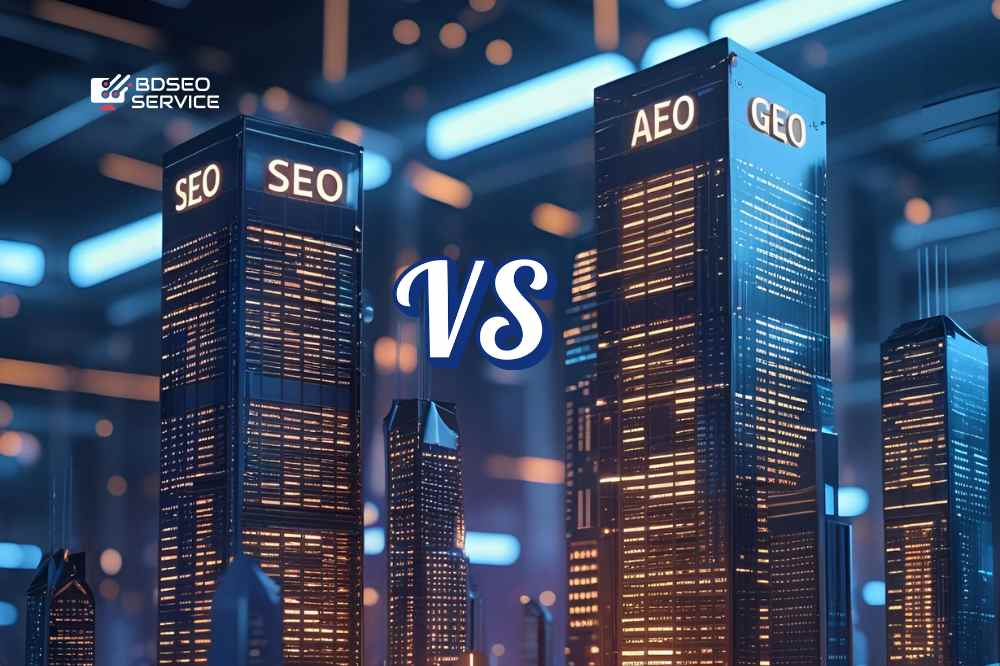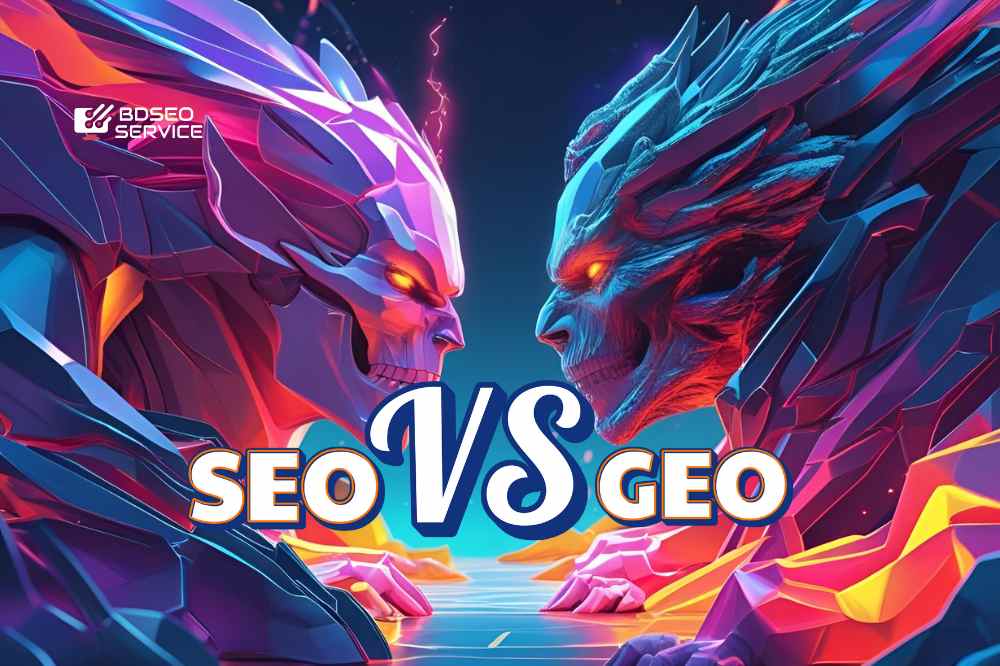The landscape of digital marketing is in constant motion, and at its heart is the ever-evolving world of search. For years, Search Engine Optimization (SEO) has been the undisputed king, the primary method for driving traffic and visibility. But the way people search is changing. Users now expect direct answers and hyper-relevant, localized results. This shift has given rise to two new contenders: Answer Engine Optimization (AEO) and Geographic Engine Optimization (GEO).
Understanding the differences and synergies between SEO, AEO, and GEO is no longer just an advantage—it’s essential for any modern digital marketing strategy. While SEO lays the foundation, AEO and GEO build upon it, creating a more robust, user-focused approach that meets audiences where they are. This guide will break down each of these disciplines, compare their goals and strategies, and show you how to integrate them to future-proof your online presence.

What is SEO (Search Engine Optimization)?
Search Engine Optimization (SEO) is the foundational practice of improving a website’s visibility to rank higher in search engine results pages (SERPs). The core goal is to attract organic, or unpaid, traffic by signaling to search engines like Google that your content is a relevant and authoritative match for a user’s query.
Core Principles and Techniques
Traditional SEO is a multi-faceted discipline built on a few key pillars:
- Keyword Research: This is the starting point. It involves identifying the terms and phrases your target audience uses when searching for your products, services, or information. Tools like Ahrefs and Semrush are indispensable for uncovering high-volume, relevant keywords.
- On-Page Optimization: This refers to optimizing individual web pages. It includes placing target keywords in crucial spots like title tags, meta descriptions, headings (H1, H2, etc.), and throughout the body content. It also involves ensuring a logical URL structure and using internal links to guide users and search engines through your site. For example, simply optimizing title tags and meta descriptions can significantly improve click-through rates from the SERPs.
- Link Building (Off-Page Optimization): This involves acquiring backlinks from other reputable websites. Backlinks act as votes of confidence, telling search engines that your content is trustworthy and valuable. High-quality links from authoritative sites can dramatically boost your rankings.
- Technical SEO: This ensures that search engines can crawl and index your website without any issues. It covers aspects like site speed, mobile-friendliness, XML sitemaps, and fixing crawl errors.
The Evolution and Limitations of SEO
SEO has come a long way from the days of keyword stuffing and link farms. Today, search algorithms are far more sophisticated, prioritizing user experience and intent. While traditional SEO techniques remain vital, they have limitations. Simply targeting keywords is no longer enough. Search engines are now focused on understanding the why behind a query, not just the what. This is where the need for a more nuanced approach to content optimization becomes clear.
What is AEO (Answer Engine Optimization)?
Answer Engine Optimization (AEO) is the process of optimizing content to provide direct, concise answers to user questions directly within the search results. As search engines evolve into “answer engines,” the goal is to claim valuable SERP real estate like featured snippets, “People Also Ask” boxes, knowledge graphs, and voice search results.
AEO shifts the focus from simply ranking for a keyword to becoming the definitive answer for a query.
How AEO Differs from SEO
While SEO aims to get a user to click through to a webpage, AEO aims to answer their question at the top of the SERP itself. This requires a different strategic mindset. It’s less about broad topics and more about specific, intent-driven questions.
Strategies for Answer Engine Optimization
Optimizing for answers involves structuring your content in a specific way:
- Focus on User Intent: Dig deep to understand the questions your audience is asking. Use tools like AnswerThePublic or browse forums like Quora and Reddit to find common queries in your niche.
- Structure for Featured Snippets: Create content that directly answers a question in a clear, concise paragraph, bulleted list, or numbered list. For example, if the query is “how to create a capsule wardrobe,” start a section of your post with a heading like “6 Steps for Creating a Capsule wardrobe” followed immediately by a numbered list. This structure makes it easy for Google to pull your content into a featured snippet.
- Use Structured Data (Schema Markup): Implement schema markup on your website. This is code that helps search engines better understand the context of your content, such as whether it’s a recipe, an event, or a product. This increases your chances of appearing in rich results.
- Optimize for Voice Search: People use natural, conversational language when using voice assistants. Frame your content around long-tail question keywords (e.g., “What is the best coffee for a French press?”) and provide direct, spoken-word-friendly answers.
- Improve Page Speed and Mobile-Friendliness: Fast-loading, mobile-optimized pages are crucial, as many AEO-driven searches happen on the go or via mobile devices.
AEO is a powerful way to build brand authority and awareness. A company that consistently answers questions on platforms like Quora, for example, can establish itself as a thought leader and drive qualified traffic back to its site.
What is GEO (Geographic Engine Optimization)?
Geographic Engine Optimization (GEO), often intertwined with local SEO, focuses on optimizing a business’s online presence to attract customers in a specific geographic area. For brick-and-mortar businesses or service providers operating in a particular region, GEO is non-negotiable. It’s about showing up when a local user searches for “restaurants near me” or “plumbers in Brooklyn.”

Optimizing for Local Search
GEO leverages signals that tell search engines where your business is located and what services you offer to the local community.
- Google Business Profile (GBP) Optimization: Your GBP listing is the cornerstone of GEO. It must be fully completed with accurate information, including your business name, address, phone number (NAP), hours, and categories. Regularly posting updates, photos, and responding to Q&As can significantly boost your local visibility.
- Build Local Citations: Ensure your business’s NAP information is consistent across all major online directories like Yelp, Yellow Pages, and industry-specific sites. Inconsistencies can confuse search engines and hurt your rankings.
- Encourage Reviews and Ratings: Positive reviews are a powerful local ranking factor. Encourage satisfied customers to leave reviews on Google, Yelp, and other relevant platforms. A restaurant that actively manages its reviews on Google Maps and Yelp is more likely to appear in the coveted “local pack” at the top of search results.
- Create Local Content: Write blog posts or create landing pages that are relevant to your local audience. A roofer in Miami might write a post titled “How to Prepare Your Roof for Hurricane Season in South Florida.” This signals local relevance to both users and search engines.
- Location-Based Keywords: Incorporate location-specific keywords naturally into your website content, title tags, and meta descriptions (e.g., “best deep-dish pizza in Chicago”).
SEO vs. AEO vs. GEO: A Direct Comparison
While these three disciplines overlap, their primary goals, strategies, and platforms differ. Understanding these distinctions is key to building a comprehensive search optimization strategy.
| Aspect | SEO (Search Engine Optimization) | AEO (Answer Engine Optimization) | GEO (Geographic Engine Optimization) |
|---|---|---|---|
| Primary Goal | Rank high in traditional SERPs to drive organic website traffic. | Provide direct answers in SERPs (snippets, voice search) to establish authority. | Attract local customers by ranking high in location-based searches. |
| Target | Broad keywords and topics. | Specific, intent-driven user questions. | Geographically-defined keywords and “near me” searches. |
| Key Strategies | Keyword research, on-page optimization, backlink building, technical SEO. | Content structuring, schema markup, voice search optimization, Q&A formats. | Google Business Profile, local citations, review management, local content. |
| Core Metric | Organic Traffic, Keyword Rankings, Click-Through Rate (CTR). | Featured Snippet Ownership, Voice Search Mentions, Brand Impressions. | Local Pack Rankings, Phone Calls, Direction Requests, Website Clicks from GBP. |
| Main Platforms | Google, Bing, DuckDuckGo. | Google’s Answer Box, “People Also Ask,” Voice Assistants (Siri, Alexa). | Google Maps, Local Pack, Yelp, Local Directories. |
The Future is Integrated: Synergizing SEO, AEO, and GEO
The most effective approach isn’t choosing one over the others—it’s integrating all three. SEO provides the technical and authoritative foundation that AEO and GEO need to succeed. A technically sound, mobile-friendly website (SEO) is more likely to have its content chosen for a featured snippet (AEO) or rank in the local pack (GEO).
Think of it this way:
- Start with SEO: Build a strong foundation with a well-structured, fast, and authoritative website.
- Layer on AEO: Structure your content to directly answer user questions, targeting featured snippets and voice search.
- Incorporate GEO: If you have a local presence, optimize for your geographic area to capture nearby customers.
Future trends point toward an even deeper convergence. AI and machine learning are making search more personalized and context-aware. Voice search continues to rise, making conversational queries the norm. Search is shifting from simple information retrieval to proactive knowledge discovery. Answering a user’s question before they even have to click a link is becoming the new standard. To succeed, marketers must adopt a holistic strategy that satisfies both search engines and, more importantly, the users they serve.
Evolve Your Search Strategy
The lines between SEO, AEO, and GEO are blurring. A truly effective search strategy in 2025 and beyond recognizes that they are not separate disciplines but interconnected components of a single, user-centric approach. By building a solid SEO foundation, optimizing for direct answers with AEO, and capturing local intent with GEO, you can create a resilient and powerful online presence that drives meaningful results.
Is your business ready to adapt to the future of search? At BD SEO Service, we specialize in creating comprehensive online marketing strategies that drive qualified traffic and help businesses grow.
Explore Our SEO Services Today and let us help you build a search strategy that stands the test of time.
